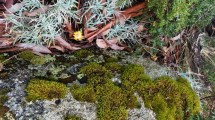Summary
-
1.
Dark adapted honeybees (Apis mellifera camica) were trained in a T-maze to discriminate spectral light stimuli (λ=533, 430, and 413 nm) from dark or from an achromatic white light stimulus.
-
2.
Bees trained to discriminate a spectral stimulus from an equally bright white light respond to the spectral stimulus as if it were the white stimulus within a certain range of intensities. This range lies between the threshold for detection of light (the achromatic threshold) and that for determination of color (the chromatic threshold); it is termed the achromatic interval. Thus the detection of spectral stimuli has two thresholds; a lower one for the absolute detection of the stimulus and a higher one for the perception of color hue. The achromatic interval for wavelengths λ=533, 430, and 413 nm is≃1.5 log10 units of light intensity.
-
3.
Trained responses to spectral stimuli disappear at high stimulus intensities. Also, bees can not be trained to spectral lights of high intensity (>2 log10 intensity units above color vision threshold). This bright light effect is attributed to the specific response function of the lamina monopolar cells.
-
4.
Achromatic vision is explicable in terms of known characteristics of receptor and neural organization in the bee color vision system. It is concluded that bees pool output of all receptors from a single ommatidium in a neural strategy which produces an achromatic signal. Bees use this neurally derived achromatic signal for orientation at light intensities near visual threshold.
Similar content being viewed by others
References
Bouman MA, Walraven PL (1957) Some color naming experiments for red and green monochromatic lights. J Opt Soc Am 47:834–839
Conn TE (1976) Quantum fluctuation limit in foveal vision. Vision Res 16:573–594
Daumer K (1956) Reizmetrische Untersuchungen des Farbensehens der Bienen. Z Vergl Physiol 38:413–478
DeValois RL (1973) Central mechanisms of colour vision. In: Jung R (ed) Handbook of sensory physiology, vol. VII/3A. Central processing of visual information. Springer, Berlin Heidelberg New York, pp 209–254
Erber J, Menzel R (1977) Visual interneurons in the median protocerebrum of the bee. J Comp Physiol 121:65–77
Frisch K von (1914) Der Farbensinn und Formensinn der Biene. Zool J Physiol 37:1–238
Hecht S, Shlaer S, Pirenne MH (1942) Energy, quanta and vision. J Gen Physiol 25:819–840
Helversen O von (1972) Zur spektralen Unterschiedsempfindlichkeit der Honigbiene. J Comp Physiol 80:439–472
Helversen O von, Edrich W (1974) Der Polarisationsempfänger im Bienenauge: Ein Ultraviolettrezeptor. J Comp Physiol 94:33–47
Hertel H (1980) Chromatic properties of identified interneurons in the optic lobe of the bee. J Comp Physiol 137:215–231
Kaiser W (1975) The relationship between visual movement detection and colour vision in insects. In: Horridge, GA (ed) The compound eye and vision of insects. Clarendon Press, Oxford, pp 359–377
Kaiser W, Bishop LG (1970) Directionally selective motion detecting units in the optic lobe of the honey bee. Z Vergl Physiol 67:403–413
Kaiser W, Seidl R, Vollmar J (1977) Spectral sensitivities of behavioural patterns in honey bees. J Comp Physiol 122:27–44
Kien J, Menzel R (1977) Chromatic properties of interneurons in the optic lobes of the bee. II. J Comp Physiol 113:35–53
Labhart T (1974) Behavioural analysis of light intensity discrimination and spectral sensitivity in honey beeApis mellifera. J Comp Physiol 95:203–216
Massof RW (1977) A quantum fluctuation model for foveal color threshold. Vision Res 17:565–570
Menzel R (1967) Untersuchungen zum Erlernen von Spektralfarben durch die Honigbiene,Apis mellifica. Z Vergl Physiol 56:22–62
Menzel R (1973) Spectral responses of moving detecting and “sustained” fibres in the optic lobe of the bee. J Comp Physiol 82:135–150
Menzel R (1974) Spectral sensitivity of monopolar cells in the bee lamina. J Comp Physiol 93:337–346
Menzel R (1979) Spectral sensitivity and color vision in invertebrates. In: Autrum H (ed) Handbook of sensory physiology, vol. VII/6A. Springer, Berlin Heidelberg New York, pp 504–580
Menzel R, Snyder AW (1974) Polarized light detection in the bee,Apis mellifera. J Comp Physiol 88:247–270
Ribi WA (1975) The first optic ganglion of the bee. I. Correlation between visual cell types and their terminals in the lamina and medulla. Cell Tissue Res 165:103–111
Rose R, Menzel R (1981) Luminance dependence of pigment color discrimination in bees. J Comp Physiol 141:379–388
Snyder AW, Menzel R, Laughlin SB (1973) Structure and function of the fused rhabdom. J Comp Physiol 87:99–135
Snyder AW, Stavenga DG, Laughlin SB (1977) Spatial information capacity of compound eyes. J Comp Physiol 116:183–207
Velden HA Van der (1946) The number of quanta necessary for the perception of light in the human eye. Ophthalmologica 111:321–346
Author information
Authors and Affiliations
Additional information
The experiments were carried out at the Department of Neurobiology, Australian National University, Canberra, Australia. Supported by a travel grant of the Australian National University. Additional support by a grant from the DFG (Me 365/7)
Gratitude is expressed to Dr. Simon Laughlin for his help during the experiments, to Prof. Dr. G.A. Horridge for his hospitality and E. Lieke for many stimulating discussions. I want to thank R. Rose, E. Lieke and Dr. D.R. Stokes for their critical reading of the manuscript, J.H. Reynolds and B. Cwienczek for typing the manuscript.
Rights and permissions
About this article
Cite this article
Menzel, R. Achromatic vision in the honeybee at low light intensities. J. Comp. Physiol. 141, 389–393 (1981). https://doi.org/10.1007/BF00609941
Accepted:
Issue Date:
DOI: https://doi.org/10.1007/BF00609941




